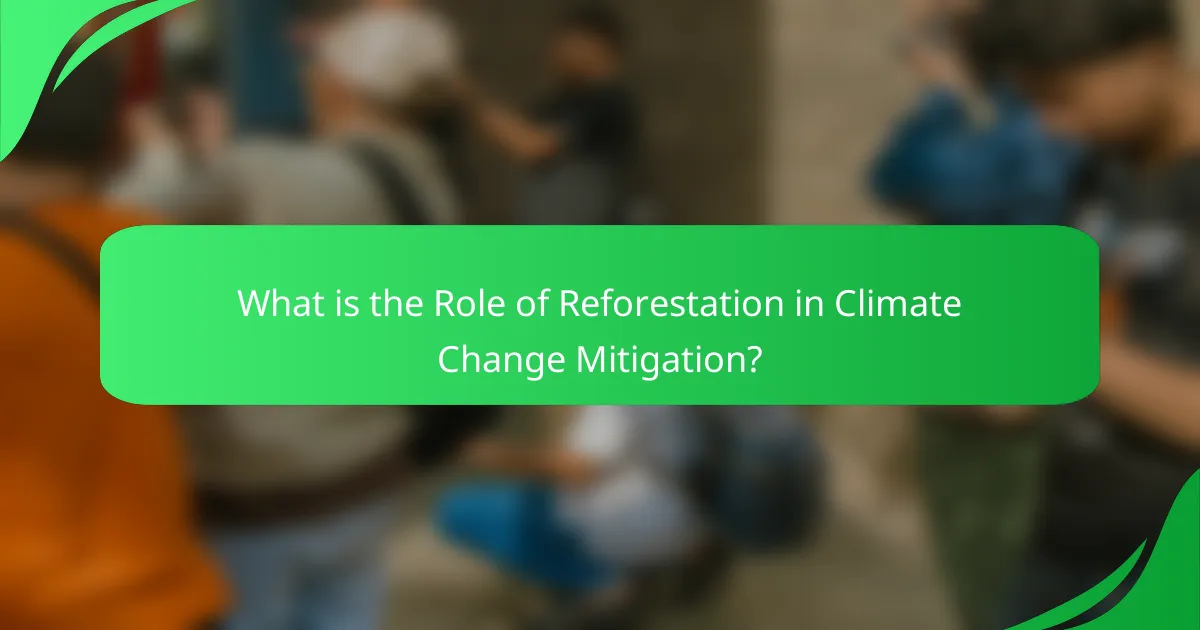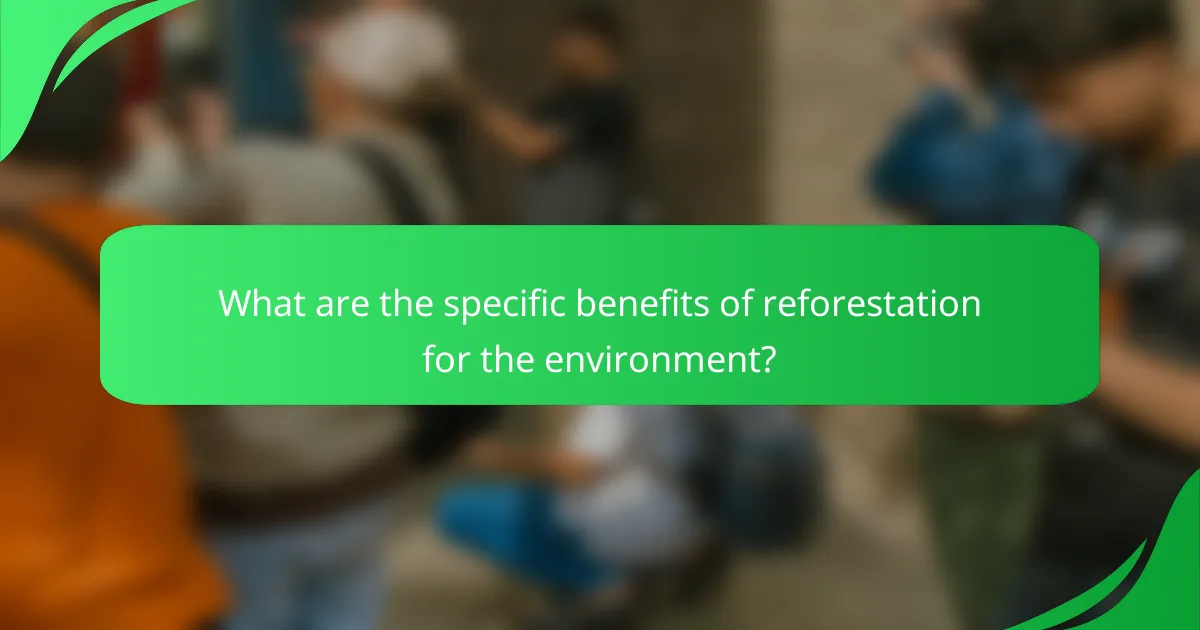Reforestation is a vital process for climate change mitigation, primarily through its ability to sequester carbon dioxide (CO2) from the atmosphere. By absorbing CO2 during photosynthesis, trees help reduce greenhouse gas concentrations, thereby combating global warming. Reforestation also enhances soil health, prevents erosion, and supports biodiversity, contributing to ecosystem resilience. Effective reforestation practices include the selection of native species, community involvement, and proper site preparation, all of which ensure successful outcomes and long-term stewardship of forested areas. This article highlights the significance of reforestation in addressing climate change and its numerous environmental benefits.

What is the Role of Reforestation in Climate Change Mitigation?
Reforestation plays a critical role in climate change mitigation by sequestering carbon dioxide from the atmosphere. Trees absorb CO2 during photosynthesis, reducing greenhouse gas concentrations. This process helps combat global warming and climate change effects. A study by the Intergovernmental Panel on Climate Change (IPCC) indicates that reforestation could sequester 1.1 to 3.3 gigatons of CO2 annually. Additionally, reforestation improves soil health by preventing erosion and enhancing nutrient cycling. Healthy soils contribute to increased biodiversity and ecosystem resilience. Community involvement in reforestation projects fosters awareness and promotes sustainable practices. Engaging local populations ensures long-term success and stewardship of forested areas.
How does reforestation contribute to carbon sequestration?
Reforestation contributes to carbon sequestration by increasing the number of trees that absorb carbon dioxide from the atmosphere. Trees capture carbon dioxide during photosynthesis, storing carbon in their biomass. This process helps mitigate climate change by reducing greenhouse gas concentrations. Studies show that one hectare of mature forest can sequester approximately 100 tons of carbon over its lifetime. Reforestation also enhances soil health, which further aids in carbon storage. Additionally, restoring forests can lead to increased biodiversity, which supports ecosystem resilience.
What processes are involved in carbon uptake during reforestation?
Carbon uptake during reforestation involves several key processes. Photosynthesis is the primary mechanism by which trees absorb carbon dioxide from the atmosphere. During this process, trees convert CO2 into organic matter, primarily in the form of biomass. This biomass includes trunks, branches, leaves, and roots, which store carbon.
Soil carbon sequestration also plays a significant role. As trees grow, they contribute organic matter to the soil through leaf litter and root decomposition. This organic matter enhances soil structure and increases its capacity to store carbon.
Additionally, root systems help stabilize soil and promote microbial activity, which further aids in carbon storage. The overall increase in forest cover leads to higher carbon storage capacity over time. Studies show that reforestation can sequester up to 1.1 billion metric tons of CO2 annually, highlighting its importance in climate change mitigation.
How effective is reforestation compared to other carbon sequestration methods?
Reforestation is highly effective for carbon sequestration. It can sequester up to 1.1 gigatons of carbon dioxide per year globally. This is comparable to other methods like soil carbon storage and bioenergy with carbon capture and storage. However, reforestation offers additional benefits. It enhances biodiversity and restores ecosystems. A study by the Intergovernmental Panel on Climate Change (IPCC) indicates that reforestation is a cost-effective strategy. It has lower implementation costs compared to technological solutions. Overall, reforestation plays a crucial role in climate change mitigation.
Why is soil health important in the context of reforestation?
Soil health is crucial for successful reforestation. Healthy soil supports tree growth by providing essential nutrients. It improves water retention, which is vital for young plants. Healthy soil also promotes microbial activity, enhancing nutrient cycling. This activity helps trees establish strong root systems. Research shows that well-maintained soil can increase tree survival rates significantly. For instance, studies indicate that healthy soils can boost reforestation success by up to 80%. Therefore, maintaining soil health is fundamental for effective reforestation efforts.
What are the key indicators of soil health affected by reforestation?
Key indicators of soil health affected by reforestation include increased soil organic matter, improved soil structure, and enhanced microbial diversity. Reforestation enhances soil organic matter by adding leaf litter and root biomass. This organic matter improves soil fertility and water retention. Improved soil structure results from increased root systems, which create channels for air and water. Enhanced microbial diversity supports nutrient cycling and disease resistance. Studies show that reforested areas have higher levels of soil carbon compared to deforested lands, indicating improved soil health.
How does reforestation improve soil structure and fertility?
Reforestation improves soil structure and fertility by enhancing organic matter content. The growth of trees contributes leaf litter and roots to the soil. This organic material decomposes, enriching the soil with nutrients. Increased root systems help bind soil particles together. This process reduces erosion and enhances water retention. Improved water retention supports plant growth and biodiversity. Studies show that reforested areas exhibit higher soil fertility compared to deforested lands. A report by the Food and Agriculture Organization highlights that reforested soils can have up to 50% more organic carbon.
What role does community involvement play in successful reforestation efforts?
Community involvement is crucial for successful reforestation efforts. Engaged communities contribute local knowledge and resources. They enhance project sustainability and maintenance. Participation fosters a sense of ownership among community members. This leads to increased commitment to the reforestation goals. Research indicates that projects with community involvement have higher survival rates for planted trees. For example, a study in Kenya found that community-managed forests had 90% survival rates compared to 60% in non-participatory projects. Active involvement also encourages educational outreach, promoting awareness of environmental issues. Overall, community engagement is a key factor in the long-term success of reforestation initiatives.
How can local communities participate in reforestation projects?
Local communities can participate in reforestation projects by engaging in tree planting activities. They can organize local events to plant native tree species. Collaboration with environmental organizations can enhance these efforts. Communities can also create nurseries to grow saplings for reforestation. Education programs can raise awareness about the importance of trees. Involvement in monitoring and maintaining planted trees is crucial for success. Local governments can support these initiatives through funding and resources. Studies show that community involvement increases the survival rate of planted trees.
What are the benefits of community engagement in reforestation?
Community engagement in reforestation enhances project success and sustainability. It fosters local ownership and responsibility for forest management. Engaged communities are more likely to protect and maintain reforested areas. Studies show that projects with community involvement have higher survival rates for planted trees. For example, a project in Kenya reported a 90% survival rate due to local involvement. Additionally, community engagement improves knowledge sharing about sustainable practices. This leads to better environmental stewardship and increased biodiversity. Engaging local populations also boosts economic opportunities through eco-tourism and sustainable forestry. Overall, community engagement is crucial for effective reforestation efforts.
How can we measure the impact of reforestation on climate change?
Reforestation’s impact on climate change can be measured through carbon sequestration rates. Trees absorb carbon dioxide during photosynthesis, thus reducing greenhouse gases in the atmosphere. Studies show that one hectare of mature forest can sequester approximately 100 tons of carbon annually. Remote sensing technologies provide data on forest cover and biomass changes over time. Ground-based measurements can validate satellite data by assessing tree growth and health. Soil health indicators, such as organic matter content, also reflect reforestation benefits. Additionally, biodiversity assessments can indicate ecosystem resilience, which contributes to climate stability. These methods collectively offer a comprehensive view of reforestation’s effectiveness in combating climate change.
What challenges do reforestation initiatives face?
Reforestation initiatives face several significant challenges. One major challenge is funding. Many projects lack sufficient financial resources to sustain long-term efforts. Another challenge is land availability. Competing land uses, such as agriculture and urban development, limit suitable areas for reforestation. Additionally, there are ecological challenges. Local biodiversity can hinder the growth of newly planted trees. Climate change also poses a threat. Changing weather patterns can affect tree survival rates. Moreover, community involvement is crucial. Without local support, initiatives may fail to achieve their goals. Lastly, monitoring and maintenance are essential. Ensuring the health of reforested areas requires ongoing effort and resources.
How can these challenges be effectively addressed?
Effective reforestation challenges can be addressed through strategic planning and community engagement. Implementing native species ensures biodiversity and resilience. Utilizing local knowledge enhances project relevance and success. Providing education on the benefits of reforestation fosters community support. Securing funding through government and private partnerships can sustain long-term initiatives. Monitoring and adaptive management help address unforeseen issues during implementation. According to the United Nations, reforestation can sequester up to 1.1 billion tons of carbon dioxide annually. This evidence supports the effectiveness of reforestation in combating climate change.

What are the specific benefits of reforestation for the environment?
Reforestation provides numerous benefits for the environment. It enhances carbon sequestration, which helps mitigate climate change. Trees absorb carbon dioxide, reducing greenhouse gases in the atmosphere. Reforestation also improves soil health by preventing erosion and enhancing nutrient retention. Healthy forests maintain biodiversity, supporting various plant and animal species. Additionally, reforestation contributes to water cycle regulation, improving local hydrology. It can reduce flooding risks by absorbing excess rainwater. Furthermore, reforestation promotes air quality by filtering pollutants. These benefits collectively support ecosystem resilience and sustainability.
How does reforestation affect biodiversity?
Reforestation positively affects biodiversity by restoring habitats and increasing species richness. The process creates new environments for flora and fauna. It enhances ecosystem services, such as pollination and water purification. Research indicates that reforested areas support a greater variety of species compared to deforested regions. For example, a study published in “Nature” found that reforestation can increase bird populations by up to 50%. Additionally, reforestation helps in connecting fragmented habitats, enabling wildlife movement. This connectivity is crucial for species survival, especially in changing climates. Overall, reforestation serves as a key strategy in promoting biodiversity recovery and resilience.
What species are most positively impacted by reforestation efforts?
Bird species, such as the spotted owl and the black-capped chickadee, are positively impacted by reforestation efforts. Reforestation provides essential habitat and food sources for these birds. Mammals like deer and bears also benefit from increased forest cover. The restoration of trees leads to improved ecosystems, supporting diverse wildlife. Insects, including pollinators like bees, thrive in reforested areas. Reforestation enhances biodiversity, leading to healthier ecosystems overall. Studies show that reforested areas can increase species richness significantly. This indicates that many species find refuge and resources in newly restored habitats.
How does increased biodiversity contribute to ecosystem resilience?
Increased biodiversity enhances ecosystem resilience by improving stability and adaptability. Diverse species contribute to a variety of functions within ecosystems. This functional diversity allows ecosystems to better withstand disturbances such as climate change or disease outbreaks. For instance, ecosystems with a wide range of plant species can recover more quickly from droughts. Additionally, biodiversity helps in nutrient cycling and pest regulation, which are crucial for ecosystem health. Studies show that ecosystems with higher biodiversity can recover from environmental stressors more effectively. Therefore, increased biodiversity is essential for maintaining resilient ecosystems in the face of changing environmental conditions.
What economic benefits does reforestation provide to communities?
Reforestation provides significant economic benefits to communities. It creates job opportunities in tree planting, maintenance, and forest management. This can lead to increased local employment rates. Reforestation also boosts ecotourism, attracting visitors and generating revenue. Healthy forests enhance biodiversity, which supports sustainable fishing and hunting practices. Additionally, restored forests can improve soil quality, leading to better agricultural yields. A study by the World Bank shows that for every dollar invested in reforestation, communities can see returns of up to $30. These economic advantages contribute to community resilience and sustainability.
How can reforestation create job opportunities?
Reforestation can create job opportunities through various activities involved in the process. These activities include planting trees, maintaining forests, and managing ecosystems. Each of these tasks requires labor, leading to the creation of jobs in local communities.
For instance, a study by the World Resources Institute found that reforestation projects can generate 1.1 to 2.6 jobs per hectare. This statistic highlights the employment potential linked to reforestation efforts. Additionally, jobs can emerge in related sectors such as eco-tourism, forest management, and conservation education.
Reforestation also supports the development of skills in forestry and environmental management. This skill development can enhance employment prospects for individuals in rural areas. Overall, reforestation serves as a catalyst for economic growth and job creation while promoting environmental sustainability.
What role does reforestation play in sustainable development?
Reforestation plays a crucial role in sustainable development by enhancing biodiversity and restoring ecosystems. It contributes to carbon sequestration, which helps mitigate climate change. Trees absorb carbon dioxide, reducing greenhouse gas concentrations in the atmosphere. According to the Intergovernmental Panel on Climate Change, reforestation can significantly lower global warming potential. Additionally, reforestation improves soil health by preventing erosion and increasing nutrient retention. Healthy soils support agriculture and food security, vital components of sustainable development. Furthermore, reforestation creates job opportunities and promotes community involvement, fostering economic growth. Engaging local communities in reforestation efforts ensures sustainable management of forest resources. Overall, reforestation is integral to achieving long-term environmental and socio-economic goals.

What best practices should be followed in reforestation projects?
Best practices in reforestation projects include selecting native species, ensuring site preparation, and involving local communities. Native species are adapted to local conditions and support biodiversity. Proper site preparation, such as soil testing and clearing invasive species, enhances survival rates. Community involvement fosters stewardship and ensures that local knowledge is utilized. Monitoring and maintenance are critical to assess growth and health. Additionally, using a mix of species increases resilience against pests and diseases. Implementing these practices can lead to successful reforestation outcomes, contributing to climate change mitigation.
How can we ensure the long-term success of reforestation initiatives?
Ensuring the long-term success of reforestation initiatives requires careful planning and community involvement. Engaging local communities fosters ownership and sustainability. Providing education on the ecological benefits of trees promotes support. Selecting native species enhances biodiversity and resilience. Monitoring growth and health of planted trees ensures proper maintenance. Implementing policies that protect reforested areas from deforestation is crucial. Research shows that reforestation projects with community engagement have higher survival rates, indicating the importance of local participation.
What strategies can be implemented to monitor and maintain reforested areas?
Implementing strategies to monitor and maintain reforested areas includes regular assessments of tree growth and health. Utilizing remote sensing technologies can provide valuable data on forest cover and biomass changes. Ground surveys should be conducted to evaluate species diversity and soil quality. Engaging local communities in monitoring efforts fosters stewardship and enhances data collection. Establishing clear management plans ensures sustainable practices are followed. Utilizing citizen science initiatives can expand monitoring capacity and awareness. Regular reporting and adaptive management practices help address emerging challenges effectively. These strategies contribute to the overall success of reforestation efforts and ecosystem resilience.
What are the best species to plant for specific environments?
The best species to plant for specific environments include native trees for local ecosystems. For dry areas, species like Acacia and Eucalyptus thrive. In wetland regions, consider planting willows and cypress. For temperate zones, oak and maple are effective choices. Tropical environments benefit from species like mahogany and teak. Each species is adapted to its environment, ensuring better growth and survival rates. Native species support local wildlife and enhance biodiversity. Studies show that planting native trees increases carbon sequestration by 30% compared to non-native species.
What resources are available for communities looking to start reforestation projects?
Communities looking to start reforestation projects can access various resources. These include grants from environmental organizations, such as the Arbor Day Foundation. Local government programs often provide funding and technical assistance. Nonprofit organizations, like Trees for the Future, offer training and support. Online platforms, such as Ecosia, help fund tree planting through searches. Community toolkits and guides are available from organizations like the World Resources Institute. These resources enable communities to plan, implement, and sustain reforestation efforts effectively.
What are the most common mistakes to avoid in reforestation efforts?
Common mistakes to avoid in reforestation efforts include selecting inappropriate species for the local environment. Using non-native species can disrupt local ecosystems. Another mistake is planting at the wrong time of year. Timing affects survival rates and growth potential. Overlooking soil health is also critical. Healthy soil supports root development and nutrient uptake. Failing to involve local communities can lead to resistance. Community engagement ensures long-term success and stewardship. Not monitoring growth and survival rates can hinder progress. Regular assessments allow for timely interventions. Lastly, ignoring climate change impacts can undermine reforestation goals. Adaptation strategies are essential for resilience in changing conditions.
Reforestation is a vital entity in climate change mitigation, primarily through its role in carbon sequestration, soil health improvement, and community involvement. The article outlines how reforestation sequesters significant amounts of carbon dioxide, enhances soil quality, and fosters biodiversity, thereby combating climate change effects. It emphasizes the importance of community engagement in ensuring the success and sustainability of reforestation efforts, highlighting best practices and common challenges faced in these initiatives. Key indicators of soil health and the economic benefits of reforestation for local communities are also discussed, providing a comprehensive overview of its multifaceted advantages.